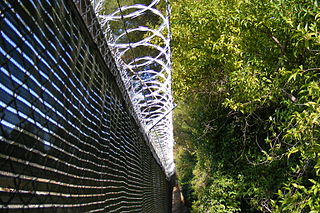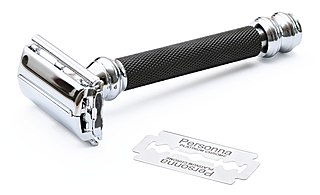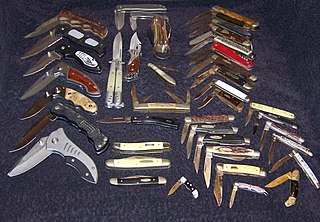Related Research Articles

Barbed tape or razor wire is a mesh of metal strips with sharp edges whose purpose is to prevent passage by humans. The term "razor wire", through long usage, has generally been used to describe barbed tape products. Razor wire is much sharper than the standard barbed wire; it is named after its appearance but is not razor sharp. The points are very sharp and made to rip and snag clothing and flesh.

A razor is a bladed tool primarily used in the removal of body hair through the act of shaving. Kinds of razors include straight razors, disposable razors, and electric razors.

A Japanese kitchen knife is a type of a knife used for food preparation. These knives come in many different varieties and are often made using traditional Japanese blacksmithing techniques. They can be made from stainless steel, or hagane, which is the same kind of steel used to make Japanese swords. Most knives are referred to as hōchō or the variation -bōchō in compound words but can have other names including -kiri. There are four general categories used to distinguish the Japanese knife designs: handle, blade grind, steel, and construction.

A safety razor is a shaving implement with a protective device positioned between the edge of the blade and the skin. The initial purpose of these protective devices was to reduce the level of skill needed for injury-free shaving, thereby reducing the reliance on professional barbers.

Stainless steels may be classified by their crystalline structure into four main types: austenitic, ferritic, martensitic, and duplex.Martensitic stainless steel is a specific type of stainless steel alloy that can be hardened and tempered through multiple ways of aging/heat treatment.
Gillette is an American brand of safety razors and other personal care products including shaving supplies, owned by the multi-national corporation Procter & Gamble (P&G).

A pocketknife is a foldable knife with one or more blades that fit inside the handle that can still fit in a pocket. It is also known as a jackknife (jack-knife) or a penknife, though a penknife may also be a specific kind of pocketknife. A typical blade length is 5 to 15 centimetres. Pocketknives are versatile tools, and may be used for anything from opening an envelope, to cutting twine, slicing a piece of fruit or even as a means of self-defense.

Wilkinson Sword is a brand for razors and other personal care products sold in Europe, owned by Edgewell Personal Care. The company was founded as a manufacturer of guns made in Shotley Bridge in County Durham, by Henry Nock in London in 1772.

A straight razor is a razor with a blade that can fold into its handle. They are also called open razors and cut-throat razors. The predecessors of the modern straight razors include bronze razors, with cutting edges and fixed handles, produced by craftsmen from Ancient Egypt during the New Kingdom. Solid gold and copper razors were also found in Ancient Egyptian tombs dating back to the 4th millennium BC.

Nabulsi is one of a number of Palestinian white brined cheeses made in the Middle East. Its name refers to its place of origin, Nablus and it is well known throughout the West Bank and surrounding regions. Nabulsi, along with Akkawi cheese are the principal cheeses consumed in Jordan. Produced primarily from sheep milk, alternatively goat's milk may be used. Nabulsi cheese is white and rectangular in shape. It is semi-hard with no gas holes. It becomes soft and elastic when heated. It is a typical ewe's or goat's milk cheese, but is traditionally flavored with mahleb and mastic added to the boiling brine. It can be eaten fresh as salty table cheese or can be fried in oil, and it is also a major ingredient of the Palestinian dessert knafeh.
Snips, also known as shears, are hand tools used to cut sheet metal and other tough webs. There are two broad categories: tinner's snips, which are similar to common scissors, and compound-action snips, which use a compound leverage handle system to increase the mechanical advantage.
The International Wool Textile Organisation (IWTO) is the international body representing the interests of the world's wool-textile trade and industry. Its members include wool growers, traders, primary processors, spinners, weavers, garment makers and retailers of wool and allied fibres, as well as organizations related to wool products.

A surform tool features perforated sheet metal and resembles a food grater. A surform tool consists of a steel strip with holes punched out and the rim of each hole sharpened to form a cutting edge. The strip is mounted in a carriage or handle. Surform tools were called "cheese graters" decades before they entered the market as kitchen utensils used to grate cheese. Surform planes have been described as a cross between a rasp and a plane.

Thiers Issard or Thiers Issard Sabatier is a French cutlery manufacturer; they are one of a number of companies using the Sabatier name. It exports a wide range of knives and straight razors to approximately thirty countries. They are viewed as one of the top cutlery firms in Europe.
Chris Reeve Knives is an American knife manufacturing corporation with international sales and distribution headquartered in Boise, Idaho, that designs, develops, and sells folding pocket knives and fixed-blade knives. Its products include the Sebenza, Inkosi, Umnumzaan, TiLock, Mnandi folding knives, Impinda slip joint, and the Green Beret, Pacific, Professional Soldier, Nyala, and Sikayo fixed blade knives. Chris Reeve Knives' industry contributions include the Integral Lock, contributions to the blade steel CPM S35VN, and has won Blade Magazine's Blade Show Manufacturing Quality Award 15 times. Their motto is Think Twice, Cut Once.

A fillet knife is a kitchen knife used for filleting. It gives good control and aids in filleting. It is a very flexible member of the boning knife family that is used to filet and prepare fish. Fillet knife blades are typically 15 to 28 cm long. This allows them to move easily along the backbone and under the skin of meat.
440C is a martensitic 400 series stainless steel, and is the highest carbon content from 400 stainless steel series. It is usually heat treated to reach hardness of 58–60 HRC. It is a bearing steel, and used in rolling contact stainless bearings, e.g. ball and roller bearings. It is also used to make knife blades. 440C can be oil quenched to achieve maximum hardness.
In steel industry terminology long steel products or long products refers to steel products including wire, rod, rail, and bars as well as types of steel structural sections and girders.

Zwilling J. A. Henckels AG is a German kitchenware manufacturer based in Solingen, Germany. It is one of the largest and oldest manufacturers of kitchen knives, scissors, cookware and flatware, having been founded in June 1731 by Peter Henckels. The brand's namesake was Johann Abraham Henckels (1771–1850), who renamed the brand after himself under his leadership.
References
- 1 2 3 U.S. International Trade Commission 2005 , p. A-3
- ↑ Peter M. Fish (1995). The International Steel Trade. Woodhead Publishing. pp. 13–14. ISBN 978-1-85573-100-4.
Bibliography
- Fish, Peter M. (1995), The International steel trade, Woodhead Publishing, ISBN 978-1-85573-100-4 .
- U.S. International Trade Commission (2005), Stainless Steel Sheet and Strip from France, Germany, Italy, Japan, Korea, Mexico, Taiwan, and the United Kingdom, DIANE publishing, ISBN 978-1-4289-5553-0 .
- Woldman, Norman Emme; Frick, John P. (2000), Woldman's engineering alloys (9th ed.), ASM International, ISBN 978-0-87170-691-1 .